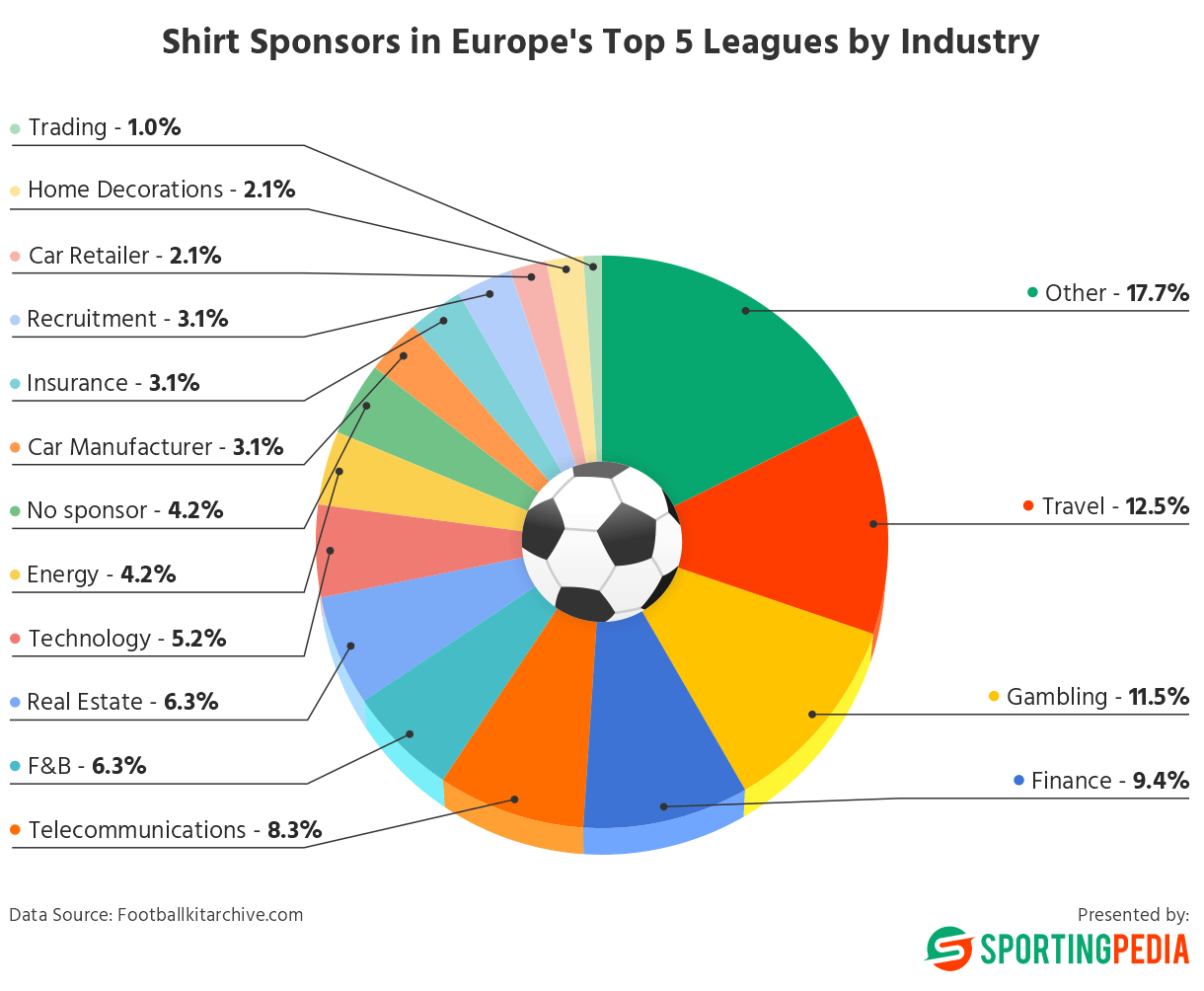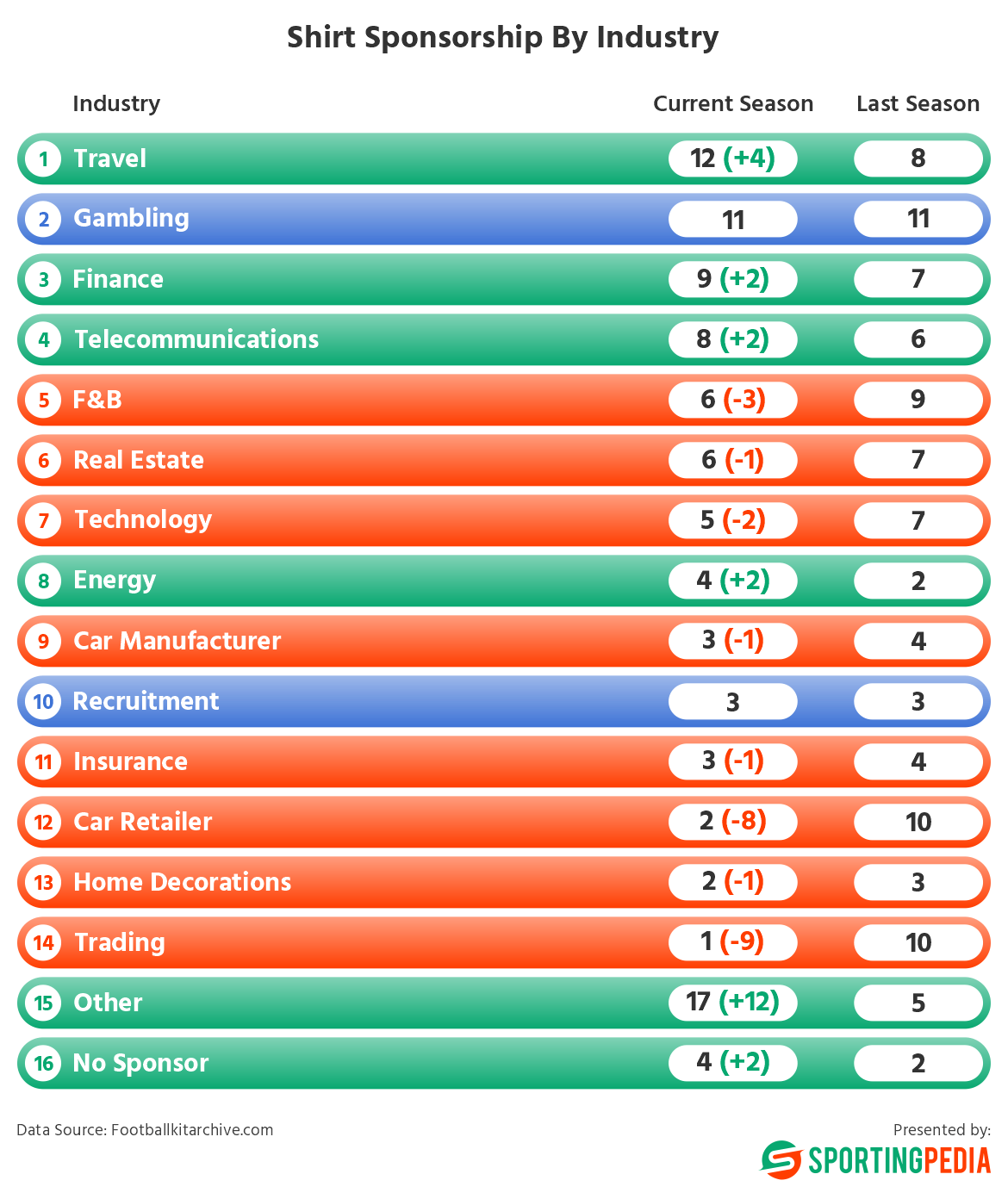Chelsea finally appeared in a Premier League match with a shirt sponsor. As recently as Monday, the London-based Blues displayed “Infinite Athlete” on their shirts, thus becoming the last team to unveil its shirt sponsor. This development inspired SportingPedia‘s team to investigate companies from which industries are the main sponsors of the teams in Europe’s top 5 leagues. After thorough research, it was revealed that the Travel sector has the lead, sponsoring 12 teams, closely followed by 11 sides backed by Gambling operators. Notably, there are still four teams without a shirt sponsor, including both Roman teams, Lazio and Roma, along with the Spanish clubs Sevilla and Real Sociedad.
Key Takeaways:
- The only two industries that have over 10% market share in shirt sponsorship are Gambling and Travel
- Paramount+ (2 teams), Fly Emirates (4 teams), DiGi (2 teams) and Winamax (2 teams) are the only companies sponsoring more than 1 team
- Companies from one industry enjoy the biggest market share in England, where the Betting operators hold 40%
- Car Retailers and Trading platforms mark a huge drop, from sponsoring 10 teams last season to 2 and to 1 now


The companies from Travel, Gambling, and Finance industries are investing the most into the top 5 European leagues. They are responsible for injecting money into 32 of the 96 clubs across the Premier League, La Liga, Serie A, Ligue 1 and the Bundesliga. The other sectors aiming at display on football shirts are Telecommunications (8.3%), Food and Beverage (F&B) (6.3%), Real Estate (6.3%) and Technology (5.2%).
It is worth noting that there are no two different companies from one sector that are investing in more than one team. Each of Paramount+ (Entertainment/Other), Fly Emirates (Travel), DiGi (Technology) and Winamax (Gambling) who are the only companies sponsoring multiple teams operates in a different branch.


This graphical depiction serves as an informative tool for understanding the shifts and alterations in the shirt sponsorship market in comparison to the preceding season.
Here’s a breakdown of shirt sponsorship in the 2023/24 season for each of the leagues:
Premier League
In the English Premier League, shirt sponsors come from eight different economic sectors. The majority, with eight teams, hail from the gambling industry, followed by four teams from the finance sector. Travel is the only other segment with multiple teams, featuring the logos of Etihad Airways and Fly Emirates on the shirts of last season’s champions and runners-up, Manchester City and Arsenal. Notably absent from the Premier League market are companies from the F&B, Trading, Real Estate, Telecommunications, and Car Manufacturers sectors.
La Liga
In Spain’s top flight, telecommunication companies hold the largest share, sponsoring four teams. Travel firms come in second place, with their brands displayed on the shirts of three sides. Sectors such as Technology, Finance, Real Estate, and Food & Beverage each have two teams under sponsorship. Sevilla and Real Sociedad are the two teams in La Liga still playing without a shirt sponsor. Gambling is forbidden, and the Trading, Car Manufacturers, Insurance, and Energy sectors are also missing from La Liga’s market.
Serie A
In Italy’s Serie A, companies in the Finance and Travel sectors are the primary investors, each sponsoring three teams. Telecommunications, Car Manufacturers, and Energy are the next most represented sectors, with two teams each. Two teams in Serie A still lack a shirt sponsor, both located in Rome – Lazio and Roma. Notably, gambling is prohibited, and the Trading, Real Estate, and Insurance sectors are missing from Serie A’s market.
Bundesliga
The German Bundesliga boasts a diverse array of companies from different economic sectors sponsoring football teams. Telecommunications and Insurance-oriented firms sponsor two teams each, while companies from eight other sectors sponsor various sides. Interestingly, Finance and Energy sectors are absent from the Bundesliga market.
Ligue 1
In the French Ligue 1, Real Estate and Travel are the only economic sectors investing in three teams each. Two teams feature the logos of Recruitment, F&B, and Gambling companies. Ligue 1’s market is notably lacking representation from various sectors, including Trading, Finance, Car Manufacturers, Insurance, Telecommunications, and Technology companies.
